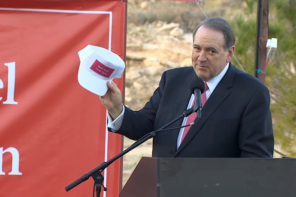While the Christian Right has been an increasingly powerful factor in American politics for decades, it has benefited from a strangely persistent culture of denialism. We needn’t review the number of times that reporters, scholars, and religious leaders who should have known better have declared that it was dead, dying, or significantly diminished. That it’s still here and stronger than ever is sufficient reason for all of us to try to get it right.
The latest version of this denialism comes regarding the New Apostolic Reformation, one of the most important Christian religious and political movements of our time and, arguably, any time. One need look no farther than the role of NAR leaders in the electoral campaigns of Donald Trump and Trump aligned figures, from school boards, to statewide elected offices, and as a dynamic part of the Christian Right.
Nevertheless there are some who claim that the NAR doesn’t even exist. We are simply going to say that it does. Others, however, deny or downplay aspects of the movement in ways that tend to obscure its significance. And while we know we cannot cover everything in this piece, and we are not going to single anyone out here, we want to dismantle the main elements of NAR denialism and briefly show how they can contribute to misunderstandings of this important movement. We also want to point to some primary and secondary sources that anyone coming to this subject will find helpful.
First, let’s point out that NAR is the preferred term of C. Peter Wagner, the convener of the most prominent and well-defined network within the wider “apostolic and prophetic movement.” There are numerous such networks around the world that are seeking to reorganize (they would say “restore”) ministerial leadership in the Charismatic and Pentecostal traditions in terms of what they call the “five-fold ministry.”
As we recently reported here on RD:
“These networks are the implementation of the only form of church governance deemed legitimate and embraced by the NAR, called the “five-fold ministry” (apostles, prophets, evangelists, pastors, and teachers), from the Book of Ephesians (4:11-13), which describes their role in the Church. The doctrines and denominations with which most readers will be familiar are, they believe, are under the influence of what Wagner called a “religious spirit”—sinful, arguably demonic, obstacles to advancing the Kingdom of God on earth.
“In adopting the five-fold ministry, the NAR holds a continuationist view, meaning that God still calls individuals to exercise the roles of apostles and prophets in the Church today, along with all the spiritual gifts manifest during the early apostolic age, including healing, prophecy, and speaking in tongues.
One of the tricks in reporting this is that people may mean different things by the terms apostle and apostolic. The Assemblies of God, the largest Pentecostal denomination, for example, issued a report in 2001 which states that most Christian denominations “think of themselves, in one sense or another, as apostolic.” But only the NAR/five-fold ministry churches “claim God has raised up present-day apostles in their midst.”
Even if the Assemblies of God recognize that some church denominations name some of their leaders “apostles,” the report emphasizes that, “since the New Testament does not provide guidance for the appointment of future apostles, such contemporary offices are not essential to the health and growth of the church, nor its apostolic nature.”
Honorifics
Too often, major Apostles and Prophets of the NAR are misidentified in news stories and magazine articles as pastors or evangelists. While they may be those things as well, the failure to more precisely recognize the nature of their leadership and their church offices is a hefty understatement, and promotes critical misunderstandings of their roles. It’s like referring to Roman Catholic Cardinal Timothy Dolan as a Catholic priest. He is certainly that, but he’s no ordinary priest.
One article named Apostle Abby Abildness as a pastor, but according to her book bio on Amazon, she “was commissioned as an apostle by John Benefiel in 2011.” Her bio on her organizational website shows her to be an important state political leader as well as an important international religious leader, although she does not in this instance, mention her title as an apostle. In a different article, Apostle Ché Ahn, one of the leading apostles in the world, was simply described as an evangelist, with no further elaboration.
In fairness, apostles and prophets don’t always feature their offices, probably because they’re opposed to what they call “the sin of religion.” This view is also expressed in their opposition to denominations (hence, non-denominationalism) and even formal doctrines. It may also have to do with lowering their profile in relation to the society they’re standing against. But reporters don’t have to go along with the PR program of NAR leaders. Just as with any other organization or movement, it’s essential to understand the nature, structure and ideology of the leadership, although it may take some research to do so. For those who are interested, there are some good places to look.
Although the NAR is best understood as a non-denominational and relational movement, C. Peter Wagner created a series of networks which nevertheless serve as a loose organizational structure. These in turn serve as models for how to do it. In 1991, Global Harvest Ministries (GHM) was founded by Wagner and fully transitioned into Global Spheres in 2012, now led by Apostle Chuck Pierce. By 2008, Wagner had reimagined GHM as a global apostolic network with an organizational structure. Some of these networks are still vital today. While some have been renamed or rebranded, the movement has grown exponentially in the U.S. and around the world.
In a July 2008 GHM newsletter, Wagner explained that many of these networks were created and led by apostles and prophets who were originally part of an intimate inner circle, the Eagles Vision Apostolic Team (EVAT) established in 2000 under Wagner’s leadership. At the time, some of the EVAT members mentioned by Wagner were: John P. Kelly, Cindy Jacobs, and Dutch Sheets of Texas; Ché Ahn of California; and John Benefiel of Oklahoma; just to name a few.
On her profile page of the Strategic Prayer Apostolic Network, Apostle Rebecca Greenwood of Colorado states that she was a “member of Peter’s apostolic roundtable, Eagles Vision Apostolic Team, which is made up of those he considered to be his closest spiritual sons and daughters.” In his recent book Modern-Day Apostles, Ché Ahn mentioned other notable EVAT members at the time such as: Lance Wallnau, Ed Silvoso, and Bill Hamon.
EVAT was a close and exclusive network of 25 people who supported Wagner financially. It’s possible that some form of the EVAT network still exists (for example, some individuals are still presented in recent online bios as being EVAT members despite Wagner’s 2016 passing; see Robert Henderson and Peter Roselle). There is, unfortunately, no public membership list.
Of course, just because Apostles, Prophets, and their own networks downplay their titles and their roles, doesn’t mean they’re necessarily hiding. They’re at the heart of the story. Primary sources to look for NAR leaders include the U.S. Council of Apostolic Leaders, International Coalition of Apostolic Leaders, the Apostolic Council of Prophetic Elders, Strategic Prayer Apostolic Network, International Freedom Group, Wagner University, and The Oak Initiative, just to name a few.
Secondary sources in English include Right Wing Watch, this video series on Apostolic Centers, and the 150 articles on the NAR published on Talk to Action between 2008 and 2011. One reliable academic book is The New Apostolic Reformation: A History of a Modern Charismatic Movement, published in 2016 by John Weaver.
One thing to keep in mind is that “apostolic networks” aren’t just for apostles. Prophets are also sometimes included on apostolic councils or teams. Ahn explains in Modern-Day Apostles that “because of the importance of working with prophets… I make sure that prophets are part of apostolic teams that I form.” One can therefore encounter “governmental” prophets on various apostolic councils and teams. Ahn gives the example of Prophet Lou Engle who’s on the International Apostolic Team of Harvest International Ministry.
Common wrong turns
One common claim is that the NAR is not an attempt to bring about a modern Reformation. The founding convener of the movement, C. Peter Wagner thought that’s exactly what it is. Regarding the NAR, he wrote in his 2008 book, Dominion! How Kingdom Action Can Change the World, “the term reformation denotes… that we are now witnessing the most radical change in the way of doing church since the Protestant Reformation.”
It’s also important to note that for Wagner, the term “new” distinguished the NAR from what he called “old wineskin denominations that include the word apostolic in their names.” When asked about the inspiration behind the NAR, Wagner linked the roots of the movement to the African Independent Church Movement in 1900, the Chinese House Church Movement beginning in 1976, and the U.S. Independent Charismatic Movement and the Latin American Grassroots Church Movement of the 1970s.
As for the lineage of his version of dominion theology, it is decidedly Reformed as he traced it “back through R.J. Rushdoony and Abraham Kuyper to John Calvin.” Wagner’s “dominion theology” is essentially a re-packaging of “sphere sovereignty,”—the idea that all areas of life must be brought under a comprehensive biblical worldview—infused with Lance Wallnau’s 7 Mountains Mandate. This is a strategy that seeks to make ideas that can seem esoteric and arcane at once accessible and comprehensible to the people they’re trying to mobilize.
Since then, the most visible and politically potent form of Dominionism has certainly been charismatic in nature. In terms of eschatology—or End Times beliefs—the trend has been to move away from premillennialism, which generally emphasizes the idea that Jesus’ return precedes the establishment of his physical kingdom on earth for a thousand-year reign, and towards what Wagner and others call a “victorious eschatology,” which promotes the idea that before the return of Jesus, the Kingdom of God will grow and fill the Earth, as the Church rises in glory, unity and maturity. For Wagner, “victorious eschatology fits dominion theology like a hand in a glove.” It’s the “primacy” of the cultural (or dominion) mandate over evangelism. Wagner believed in the total and complete victory of Christianity for eternity.
Many in the NAR and beyond share this general view. Some oppose this trend or may find it politically inconvenient, but their discomfort doesn’t change the reality.
Turning a blind eye to the theocratic implications of the NAR’s theology of political power is of a piece with earlier denials of the existence or significance of Dominionism. These denials had partly to do with the role of Christian Reconstructionism (the Reformed movement led by 20th century theologian R.J. Rushdoony) in providing a theological rationale to engage in politics along with biblical justifications for an evangelical public policy agenda.
This became something of a political crisis for conservative Republican candidates for president in 2008 and 2012 who were directly involved with Dominionists, including NAR leaders. Most dramatically, leading NAR figures staged an unprecedented prayer rally of some 30,000 people in Houston to launch Texas Gov. Rick Perry’s 2012 campaign. Even the octogenarian C. Peter Wagner traveled from Colorado to attend.
Another common mishap is to characterize various apostles and prophets as “self-appointed” or “self-anointed.” In fact, in the networks established by Wagner, there is a process of mutual recognition of apostolic and prophetic leadership, as people having been called by God. And while self-appointment may be true for some opportunistic leaders in the wider apostolic movement, it is important to establish when this is in fact true, rather than assuming that it’s always the case.
Similarly, while there is certainly an authoritarian, or at least anti-democratic streak in the NAR approach to religious and political authority, it’s more complicated than how the term authoritarian may be generally understood. Since the NAR and the wider apostolic and prophetic movement is so different from any kind of traditional Christian denomination, understanding of the five-fold ministry isn’t really optional—even though it may take a few extra sentences to explain.
Another source of confusion is that NAR figures in the news are sometimes misidentified. Christian musician Sean Feucht, who also self identifies as a speaker, author, missionary, activist, and founder of multiple global movements, became prominent staging concerts protesting church closings and restrictions during the height of the Covid crisis. He also ran unsuccessfully as a Trumpian candidate for Congress in 2020, and provided the entertainment at Doug Mastriano’s 2022 GOP gubernatorial primary victory party.
Some claim that he isn’t NAR (or say nothing about his affiliation at all). However a simple look at his bio shows otherwise. Feucht was a volunteer worship leader at Bethel Church, headed by Apostle Bill Johnson, and went on to form his own ministry Burn 24-7, which has a “Spiritual Oversight” board, listed on its website, mostly comprising prominent NAR figures. This is significant, if for no other reason than if, say, an organization is led by someone with a Methodist history, and the listed spiritual advisors are Methodist Bishops, there would be nothing controversial about the idea that it’s a Methodist oriented group. What’s more, to ignore or fail to research the Methodist connection would be a disservice to both the subject and the readers.
Just as in any other religious movement, not everyone is a ministerial leader, though the NAR seeks to create ministerial functions for everyone. For Wagner, social transformation was done essentially through what he called “the Church in the workplace.” This is why the idea of the 7 Mountains broadens the roles of religiously inspired leadership. And that’s because these seven areas of culture (religion, family, government, business, education, media and arts & entertainment) can each be a “ministry” that may have nothing to do with traditional church roles, but everything to do with actualizing the vision of removing demonic forces from the pinnacles of power and replacing them with Christians intent on bringing about the Kingdom of God.
Similarly, there has been, until recently, a remarkable lack of focus on Doug Mastriano’s relationship to the NAR, perhaps leaving much about the nature of his campaign for governor undiscovered. Back in March 2022, for example, there was a long rally in Spooky Nook, Pennsylvania for Mastriano’s GOP primary campaign. An alert researcher recently found something that no one else had noticed in a video of the rally posted on the campaign’s Facebook page.
In his remarks Mastriano reveals (at 3:12) that he is God’s prophet, declaring, “God spoke through a donkey,” (referring to the story of Balaam in the biblical book of Numbers.) “He’s speaking through Doug Mastriano right now.” Also, PBS station WHYY’s investigation, published on September 1st, revealed that Mastriano’s campaign manager, Vishal Jetnarayan, “describes himself, and is described by others, as a prophet. He says he speaks with God directly and gives advice on how others can do so.”
The knowledge and vocabulary
These things said, reporting on the NAR has significantly improved from the past years when the movement was completely ignored and when many, sometimes ruthlessly, downplayed its role in American politics and the implications for the future of democratic institutions. (There has even been some more recent outstanding reporting that helps us to see what we’ve been missing.) People are finally starting to pay greater attention. Nevertheless, some will continue to deny the existence of the NAR, and some will persistently minimize the political involvement and influence of key NAR leaders in American public life.
It’s up to all of us, but especially journalists, to understand how the NAR’s theology of political power poses a threat to democracy. And in order for democracy and its institutions to appropriately respond, it’s essential that we all work to get the story right. This means acquiring the knowledge that it takes to tell the story, as well as the vocabulary to be able to describe and discuss this, an important feature of the religion and politics of our time.
This is the first of a three-part series, A Reporter’s Guide to the New Apostolic Reformation. Read Part II: When it Comes to Societal Dominion, the Details Matter & Part III: Call it ‘Christian Globalism’





